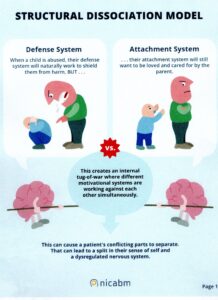A bit like dissociation, narcissism can be regarded as one of the “bad boys” of human growth and development; see more on this in the Defence Mechanisms. This judgement may do a disservice to narcissism, and the part it plays in our lives.
So where does the term come from?
The story of Narcissus
Narcissus, pictured above, was a hunter in Greek mythology, son of the river god Cephissus and the nymph Liriope. He was a very beautiful young man, and many fell in love with him.
However, he only showed them disdain and contempt. He preferred to look at his own reflection in the water concluding only that he was not ‘beautiful enough’.
One day, while he was hunting in the woods, the nymph Echo spotted him and immediately fell for him. Narcissus sensed that someone was following him and Echo eventually revealed herself. She tried to hug him. However, he pushed her off and told her not to disturb him. Echo, in despair, roamed around the woods for the rest of her life wilting away until all that remained of her was an echo.
For you and me, the story warns us about falling in love with ourselves rather than others – so much so that we miss the love and compassion that surrounds us.
So how might this Greek myth help with small, safe experiments?
What use is the story of Narcissus, apart from being Greek myth providing 20th century therapists with one of many metaphors? Apart, that is, from me being fond of my narcissistic part (there’s a joke in there some-where!)
There is a useful, if detailed account, of our narcissistic ‘part’ available via the Cognitive Analytic website.
Here are my own thoughts with a ‘slant’ on how narcissism can respond to safe experiments.
Parts?
In this account, and through this website, I refer to ‘parts’.
This is a problematic word and it can cause disputes between professionals and, indeed, between professionals and clients. However, it is difficult to invent a proper word that fits the bill.
Furthermore, the idea of a ‘part’ is pretty central to psychology – Freud‘s id, ego and superego and Berne’s Parent, Adult and Child being just two models with ‘parts’ that are well know to many.
Internal Family Systems, led by Richard Schwartz and others, is a modern re-development of parts work. I’d give mention, as well, to John Omaha’s work on Parts Therapy coming, as it does, out of the clinical hynotherapy approach.
So, I am going to ask you to bear with me, as I assert that all our ‘parts’ can be both healthy or unhelpful, even at one and the same time! Those parts can be very different from one another, and, sometimes, very ‘in tune’ one with another.
One aim of therapy is to improvement our level of attunement.
Attunement through secure attachment and integration of parts
So let me say more. In a normal attachment relationship, the small child will gaze into a carer’s eye – as they so often do – and they will see themselves. It is likely that ‘mirror’ neurons in both carer and baby start to buzz in harmony.
Do you remember the scene in Spielberg’s Close Encounters of the Third Kind, when the alien spaceship and the Earth scientists found a way to communicate through music! Could it be like that?
As the child grows, an intimate relationship can be extended to others. Because we are all different, each relationship is different as it evolves. Each has a different impact on the psycho-sexual and psycho-social development of the child as it incorporates an idea of each relationship into its growing personality. Transactional Analysis (TA) has much to say about how this is done.
When that integration works, then each part can talk to one another, and the total being remains in harmony, for the most of the time. The individual will make a (roughly) ‘normal’ development into adulthood.
However, that process of integration is easily disrupted
For instance, if that initial gaze into the eyes of a parent (for the most part) does not happen, then the child is not able to see that reflection and feel a ‘connection’ with the carer.
That is a lonely experience. In time – that child will find its reflection somewhere else. The obvious place to look is in a mirror – literally or metaphorically. At that point, the child can see only herself. In due time, the child learns self-sufficiency; one based on a growing confidence in her ability to stand alone; to have mastery of the seas and continents.
However, it is a ‘cover job’, and deep down there is uncertainty, anxiety and self-doubt.
So that superficial mastery is an illusion. Indeed, through the process, the child itself will develop a sneaking suspicion that all is not well; sensing that something is missing. The child learns to put that doubt into a box and to keep it separate – hidden from other parts – a secret. Over time, a visible split can develop between the content of that ‘box’ and other parts of ourselves.
More on Dissociation
Sometimes this split is known to the individual – it becomes a structural dissociation. Other times the split is not so evident and the individual can develop a Dissociative Identity Disorder (DID). This can be problematic for the individual and other people in her life.
The US-based National Institute for the Clinical Application of Behavioral Medicine (NICABM) have a very clear way of presenting this split:

One obvious split that can emerge is between admiring and contemptuous parts.
Here, the admiring/admired part, helping me feel special and admired, fosters omnipotence. By contrast, the contemptuous part devalues both the self and others. Those contradiction – perhaps a special case of catastrophising – can lead to deep feelings of worthlessness and vulnerability.
It may help to do a safe experiment to monitor any catastrophic language you use – the ‘always’, ‘nevers’, ‘worsts’, ‘disasters’ and the like. If you ‘hear’ them in your head consider: are there different words that might describe your position/reaction in a more specific way?
Are there changes you’d want to practise when describing your own life narrative – in your own head, or in conversation with others?
Most of us would find such strong feelings unbearable. It’s understandable that there is a drive to hide a ‘part’ away but our language can conspire to support that drive. The tension in us can manifest in a pervasive anxiety arising from a suspicion that something is wrong.
In its strongest form, this tension can manifest in a wish to be invisible; to become a ‘nobody’. Editing our language can provide an opportunity to re-calibrate our perceptions of self and others.
Small defeats can arise from any sense of failure arising with such safe experiments. We can all have experiences in life that provide ‘evidence’ of failing. It’s not such a long stride to generalise from specific failures to a sense of being a failure.
So what’s the something just a bit different you can do that might help?
A contribution from Transactional Analysis
These tensions are so profound that is difficult to think of the small, safe experiments that might promote change. Even so, The Transactional Analytic (TA) notion of the Driver can help.
All that is said above is likely to manifest in highly ‘driverised‘ behaviour.
For instance, Be Perfect can set up a tendency to build up conditions of excellence for self or others that are arduous. When my Be Perfect succeeds, excellence is rewarded by the admiring part. Given the standard is high, and some failure is almost inevitable, then Be Perfect is bound to fail on the way; a large obstacle on our scenic route – usually accompanied by a 0 – 60 mph shift into the contemptuous part.
Because the feelings are so strong and unpleasant, it’s possible that the pain will be lessened by creating contempt for others – that, at least, shifts of some of the blame.
The TA perspective is helpful as it identifes ‘antidotes’ to highly driverised behaviour. In the case of Be Perfect, it is: it’s OK to make mistakes. It follows that all the safe experiment information on Affirmations has some part to play in the process of healing – or, in this case, the re-integation of parts. There is now an additional page on compassion-focused therapy that has its own Drive system as one of three systems making change possible.
Another strategy to keep in mind is acceptance of self and others. ACT is a therapeutic model well able to harness self-compassion. Even so, this assumes we can be respectful of the struggle experienced by the contemptuous part as we acknowledge the validity of any self-compassion, in the first place!
It’s not often easy to know what different parts are trying to tell us; it can be easier to lock them away as not remotely helpful.
That’s why I would want to be less judgemental about our defence mechanisms. Most are there for a very good reason – even if it is one from way back when.
